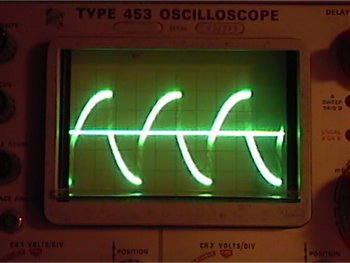Shaka Express Clipping Characteristics
By Paul Marossy
Last
Updated 8/21/04
When I did this study, I was mainly interested in how that bite control
affects the signal since it has such a large inpact on the sound. What
I found is pretty interesting. The scope used was a Tektronix Model 453,
settings were as follows: Volts/Div 10mV, Time/Div 0.5uS, Slope set to "+".
I put the scope in chop mode with no input on B to give a flatline to
reference to. A 600Hz sine wave at 20dB attenuation was fed into the
input of the Shaka Express. Unless noted otherwise, the Shaka Express
control settings were as follows: Tone 12:00, Vol 5:00, Gain 5:00, Bite
control was varied, as noted below. What you see here is at the output
of the pedal.
Here is the sine wave as it came from the signal generator. The Volts/Div switch was set to 1V for this shot only.
Here the bite control is at 7:00. This sounds the brightest/harshest to my ears. Notice the sharp spikes at the leading edge of what is essentially a slightly asymmetrical square wave.
Here the bite control is at 10:00. The tops are starting to get a little more rounded and it sounds a little less harsh to my ears.
Here the bite control is at 12:00. Everything has gotten much more rounded now. This sounds better to my ears. Notice the curious non-linear slopes of the waveforms.
Here the bite control is at 3:00. This is stills seems to sound a pretty good to my ears. The waveforms now look something like shark fins.
Here the bite control is at 5:00. This sounds a little muffled to me. The waveforms have changed quite a bit in a small increment
This is with the bite control at 5:00 and the tone control set at 3:00. Volts/Div switch changed to 50mV. Essentially a square wave with rounded tops. Asymmetrical clipping is evident, as is in all the previous shots.
This is with the same settings as the picture above, but with Ed Rembold's mod at T3 switched on (470K voltage divider after C9). Asymmetrical clipping is evident once again. This seems to sound a little better to me than the one above, but the waveforms don't look that different, other than the sides have a little more slope to them. This makes for a little softer clipping.
Having satisified my curiousity, I can now say that I know how this bite control
affects the sound. It is also a curious thing how the shape of the waveforms
have a correlation with how it sounds. Sharp edges sound kind of harsh.
Square waves sound buzzy. Smooth sine waves sound kind of plain. Classic
soft clipping sounds pleasant as well as asymmetrical clipping.
I hope you found this to be as interesting as I have.







